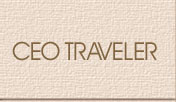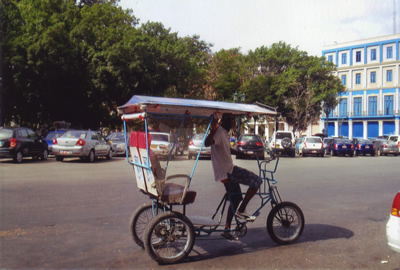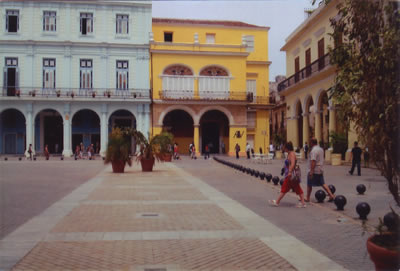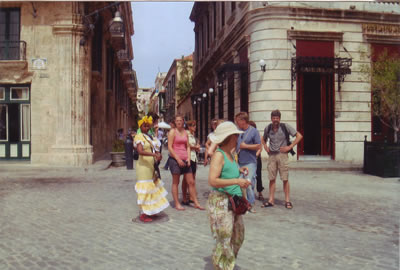 |
|
|
|
|
|
|
|
|
|
|
|
|
|
|
|
|
|
|
|
|
|
|
|
|
|
|
 |
 |
|
|
|
|
|
|
|
|
|
|
|
|

|
Cuba
Traveling to Cuba is like stepping back into 1959, the year that Fidel Castro came to power and turned this beautiful island nation into a communist state. Tour guides say "expect the unexpected" when you visit and I certainly had many unexpected moments when touring the country recently. For openers, you cannot simply hop on a regularly scheduled airliner to fly from the United States to Havana. The U.S. has imposed an embargo on trade with Cuba and there are many restrictions on individual travel to that country. For most people, it means that you can go to Cuba legally only as a member of a professional, academic or religious group who has signed a travel affidavit certifying a valid reason for the journey. The flights from New York, Miami and Los Angeles to Havana's Jose Martin Airport are charters. Upon arriving, I found that tourists are generally treated well, with a number of first-class hotels and restaurants available to them, and generally cocooned from the deprivations of residents. Cubans, however, have a tough life. Food is scarce (rationing exists for the limited supplies of government-subsidized goods), housing is limited (two or three families may share an apartment) and public transportation is sporadic (buses are infrequent and trains are slow). But the Cubans I spoke to, while chafing under the prevailing censorship and lack of international travel opportunities, love their country. Everyone seems to be fed, if not well-fed. Health care, whatever the quality, is free. And there is no charge for higher education, although it is quite difficult to get into Havana University, the top college in the nation. In addition, two parallel economies exist in Cuba – one based on the local peso and the other on the dollar. Cubans are paid in pesos, the official currency with no international value, while American tourists have access to, and spend, either dollars or a special type of currency called the convertible peso. Salaries are low, including those of doctors, lawyers and other professionals. The wealthiest people appear to be artists, guides and others (even waiters and bartenders) whom tourists pay in dollars, a hard currency that was much in demand among the people I met. Our group had a briefing at the U.S. Interests Section, a building complex that is, in effect, the American embassy, since the United States does not have official diplomatic relations with Cuba. The State Department employee who briefed us said that Cuba was a hardship post for Americans and noted that when she was about to give birth, she returned home because the medical facilities were much better there.
Just about all of the cars on the streets are pre-1960 models, seemingly held together with spit. A half-dozen Cadillacs, Pontiacs and Buicks, with engines that had been replaced a few times and bodies that had been polished to a shine, were parked in front of my Havana hotel, the Parque Central, serving both as taxis and subjects for photographs. Bicycle taxis are also in abundance. The touristy part of the city is Old Havana, with its four main squares or plazas, one of the oldest cathedrals in the Americas and hundreds of architecturally-important buildings. Also in this section is the Prado, an avenue with a long park in the center where locals congregate to talk and perhaps participate in black-market activities. Our group toured the National Fine Arts Museum and the Museum of the Revolution, which are also in Old Havana. If I had any doubts that we were under observation by the government during our weeklong stay in Cuba, they were dispelled at the fine arts museum, when my friend left the guided group to find the gift shop. She asked an attendant on the top floor for directions and as she walked to the ground floor, every attendant on the way knew in advance where she was going. In central Havana is the Malecon, a boulevard that runs along the Straits of Florida. On one side of this thoroughfare is a sea wall, where Habaneros come to sunbathe or fish off the rocks. On the other are eclectic office buildings and magnificent mansions, many unoccupied and in various states of disrepair and reconstruction. By world standards, crime is rare in Cuba, but prostitutes still roam the Malecon in the evenings to lure foreigners. Also worth a trip while in the city is the main cigar factory of Cuba, where a lector reads books over a microphone to the tobacco rollers – a tradition that is said to be responsible for the Montecristo brand, named after the famous Dumas novel. In an old firetrap of a building, you can follow the production process from beginning to end, winding up at a shop where the various types of cigars made there are sold. The United States has imposed a blanket ban on importing cigars, but some American travelers put them in their luggage nevertheless.
Another must for tourists is the magnificent Hotel Nacional de Cuba, where the musicians of the Buena Vista Social Club, who were made famous by the movie of the same name, often perform. Designed more than 80 years ago by the architect of the Breakers Hotel in Palm Beach, the art deco Nacional is a national monument with grand public areas, pretty gardens and photographs of famous guests on the walls inside. There's more to Cuba than Havana, of course, so I was happy to get into the countryside for a couple of days to see two small cities, Cienfuegos and Trinidad. Cienfuegos is on the southern coast, with buildings that reflect both French and Moorish influences. Further east is Trinidad, with colonial architecture and an open air flea market for crafts and trinkets that tourists haggle over and buy. I had heard about Ernest Hemingway's home and gardens in Finca la Vigia, a suburb of Havana, which the government has turned into a museum celebrating the author's life, and was therefore eager to see it. Visitors are not allowed inside the residence, but by peering through the open windows and doors, you can glimpse the kind of life that Papa enjoyed during his many years in Cuba. Another stop on the Hemingway trail, albeit a tourist trap, is El Floridita, a Havana bar known for its daiquiris. Like a lot of Americans before me, I left Cuba with mixed emotions. Sadness that the long-suffering Cuban people are forced to survive with barely the basics of life. And joy that so many of them hope for a better future, when trade and diplomatic relations with the United States may be restored. If you go, the unexpected may follow you too. Leonard Sloane |
||||||||


